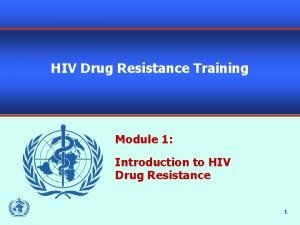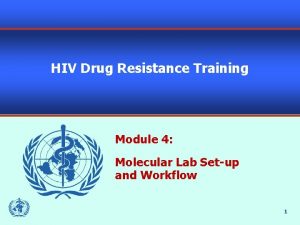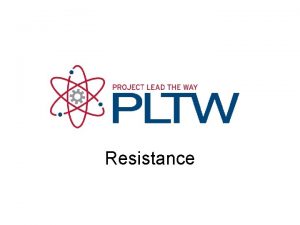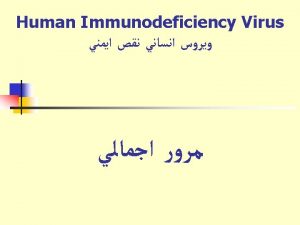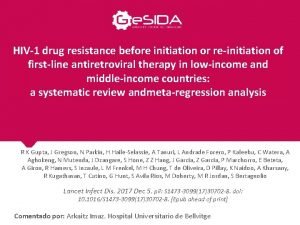HVDRS STUDY RESISTANCE WE CARE HIV1 DRUG RESISTANCE








- Slides: 8

HVDRS STUDY RESISTANCE: WE CARE HIV-1 DRUG RESISTANCE SURVEILLANCE AMONG PARTURIENT WOMEN ON ANTIRETROVIRAL THERAPY IN THE EASTERN CAPE, SOUTH AFRICA *Oladele Vincent Adeniyi 1, Chikwelu Larry Obi 2, Daniel Ter Goon 3, Benson Iweriebor 2, Anthony Idowu Ajayi 4, John Lambert 5, Anthony Okoh 1 Affiliations (1)Faculty of science and Agriculture, University of Fort Hare, Alice. Email: vincoladele@gmail. com; aokoh@ufh. ac. za. (2) School of Science and Technology, Sefako Makgatho Health Sciences University, Pretoria. Email: C 355251@gmail. com; benvida 2004@yahoo. com. (3) Faculty of Health Sciences, University of Fort Hare, East London. Email: dgoon@ufh. ac. za. (4) Faculty of Social Sciences & Humanities, University of Fort Hare, East London. Email: ajayianthony@gmail. com. (5)University College Dublin/Mater Misericordiae University Hospital, Catherine Mc. Auley Education & Research Centre, Dublin, Ireland. Email: jlambert@mater. ie.

BACKGROUND • HIV prevalence of 30. 8% among pregnant women and over 95% ART coverage in the country(1, 2). • About 320, 000 children were living with HIV in SA and 12, 000 new paediatric infections occurred in 2016 (3). • Emergence of HIV drug resistance poses significant threat to the goal of elimination of mother-to-child transmission (4, 5, 6). Low viraemia 25% [CATEGORY NAME] ([PERCENTAGE]) probable virological failure 19% Suppressed 57% 10000 -99999 8% 100000 and above 3% Suppressed Low viraemia 1000 -9999 10000 -99999 100000 and above

RESEARCH QUESTIONS • What proportions of pregnant women delivering at high viral load have acquired clinically relevant Drug Resistance Mutations (DRMs)? • What are the patterns of DRMs in a failing c. ART regimen in pregnant women in the Eastern Cape, South Africa? • Findings on the frequency and pattern of HIV drug resistance mutations in pregnant women with high VL might give inform new strategies and innovations in the efforts towards eliminating MTCT.

METHODS • We conducted genetic analysis on viral isolates (n=80) from plasma samples of women with probable virological failure at delivery between January and May 2018 from two large maternity centres in the Eastern Cape. • Partial pol gene covering 1030 bp were amplified and sequenced according to standard protocols. • DRMs were determined by submitting the generated partial pol sequences to the Stanford Genotypic Resistance interpretation algorithm (http: //hivdb. stanford. edu/pages/algs/HIVdb. ht ml) for query on mutations associated with drug resistance. • We examined the correlates of DRMs using bivariate analysis.

RESULTS AND DISCUSSIONS Participants: • Age - 16 - 43 yrs. • Predominantly on EFV-based ART (82. 5%) and at least 12 months (65%). • Median durations on EFV-based ART = 21 months and PI-based ART = 42 months. • Median duration on PI-based ART after switching therapy was 11 months. • Mean CD 4 count = 273 (interquartile range of 3 – 759).

Drug Resistance Mutations in Viral Sequences • Overall, HIV-1 DRMs occurred in 58 (72. 5%) viral sequences. • DRMs prevalence in EFV-based ART = 69. 7% and PI-based ART = 87. 7%. • In the RT gene, the predominant mutation was K 103 N (n=43/58; 74. 1%); in EFV-based ART = 79. 1% (n=34). • The prevalence of K 103 N in PI-based ART after switching from 1 st line ART = 20. 9% (n=9). DRMS Freq. Percentages (%) Major NNRTI Mutations *K 103 N (Confers resistance to 43 74. 1 EFV/NVP) V 106 M 9 15. 5 V 108 I 5 8. 6 P 225 H 10 17. 2 K 101 E 2 3. 4 Y 188 L 4 6. 9 Major NRTI Mutations *M 184 V (Confers resistance to 28 48. 3 3 TC/FTC) *K 65 R (Confers resistance to TDF) 11 19. 0 K 70 R/E (TAM) 4 6. 9 K 219 Q (TAM) 4 6. 9 Major PI Mutations 1 1. 7 V 82 L

Bivariate Analysis of Clinical Correlates of HIV DRMs • NNRTI-associated resistance mutations tend to Variables All DRMs No DRMS p-value predominate in women delivering their index pregnancy at high viral load in SA. CD 4 Count <200 24 (34. 3) 23 (95. 7) 1 (4. 3) 0. 002 200 -349 24 (35. 8) 13 (54. 2) 11 (45. 8) 350 -499 14 (20. 9) 11 (78. 6) 3 (21. 4) 500 6 (9. 0) 2 (33. 3) 4 (66. 7) I 44 (62. 0) 28 (63. 6) 16 (36. 4) 0. 304 II 11 (15. 5) 9 (81. 8) 2 (18. 2) III 14 (19. 7) 12 (85. 7) 2 (14. 3) WHO Stage IV 2 (2. 8) 1 (50. 0) • Despite switching to PI-based ART, NNRTIassociated mutations still persist (Archived resistance) for almost a year. • Studies have demonstrated onward transmission of these maternal DRMs to newborns (7, 8). • Clinicians should monitor viral load and switch regimen promptly while addressing adherence challenges among pregnant women on ART. • In conclusion, DRMs remain a threat to achieving the goal of elimination of MTCT in South Africa. • Recommendation: A point-of-care RT-PCR kits for screening for common resistance mutations in order to guide appropriate neonatal prophylaxis and maternal therapy.

ACKNOWLEDGEMENTS




